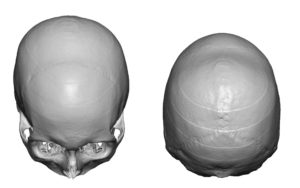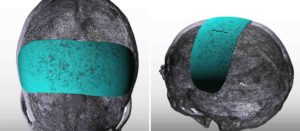Background: The shape of the skull is prone to a wide variety of defects consisting of either lack of adequate projection, too much projection or a combination of both. Usually these occur in very specific and recognizable patterns and are seen relatively commonly in my practice. Almost always there is a biologic explanation for their existence either related to external deformation or some association with one of the skull sutures.
Most skull deformities associated with a suture present as a raised area due to bone growth being restricted perpendicular to its linear direction. A bone thickening occurs as it builds up along the sutural indentations with growth. (e.g., sagittal crest deformity) Conversely, sutural indentations or areas of depression along or around them are caused by external forces which have compressed a wide area of bone in which the suture resides. (e.g., occipital plagiocephaly)
But occasionally skull deformities are seen that defy an exact explanation as the following case study illustrates.


Custom Skull Implant for Sagittal Suture Depression Dr Barry Eppley IndianapolisUnder general anesthesia a 3 cm long sagitally-orieted scalp incision was made in the midline over the depression. This permitted subperiosteal dissection to be done along the side to side skull depression. The implant was then inserted, positioned and then secured in the midline with two small microscrews.
This unique discrete skull depression was effectively treated with virtually next to no scarring using the custom skull implant approach. While an explanation could not be given as to why such a skull depression occurred, that did not deter a satisfactory skull reshaping result.
Case Highlights:
1) An unusual type of aesthetic skull deformity is one that goes horixotally across the top of the head along the coronal suture lines.
2) A custom skull implant can be made to augment the coronal suture defect to bring it up to the level of the rest of the skull’s surrounding surface.
3) Such a linear custom skull implant can be placed through an incredibly small scalp incision.
Dr. Barry Eppley
Indianapolis, Indiana




